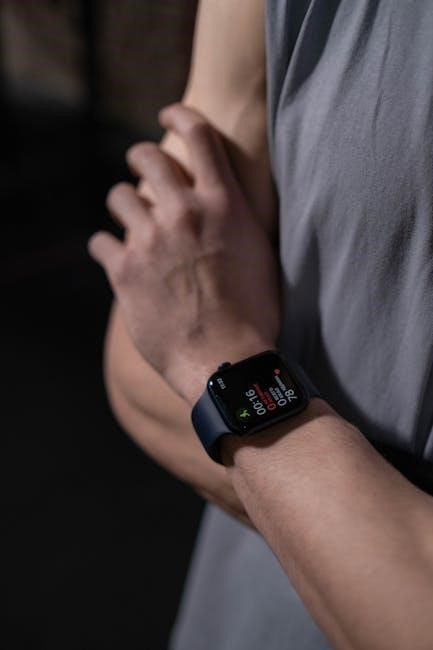Exercises for iliotibial band syndrome are available in pdf format online, providing detailed instructions and illustrations for proper technique and safety, using tags like h2 for headings and p for paragraphs.
Understanding Iliotibial Band Syndrome
Iliotibial band syndrome is a common overuse injury that occurs when the iliotibial band, a ligament that runs down the outside of the thigh, becomes inflamed and irritated. This can cause pain and discomfort on the outside of the knee, especially when bending or straightening the knee. The iliotibial band plays a crucial role in stabilizing the knee and helping to extend the leg, so when it becomes inflamed, it can be difficult to perform everyday activities. According to online resources, including pdf files, understanding the causes and symptoms of iliotibial band syndrome is essential for developing effective treatment and rehabilitation plans. By learning more about the condition, individuals can take steps to prevent further injury and promote healing. With the right information and guidance, it is possible to manage the symptoms of iliotibial band syndrome and return to normal activities. Using online resources, such as pdf files, can provide valuable information and support for individuals affected by this condition.

Causes and Risk Factors of Iliotibial Band Syndrome
Risk factors include repetitive knee bending and overuse injuries, often affecting runners and cyclists, using tags like h2 and p for formatting purposes online every day.
Repetitive Knee-Bending Activities and Overuse Injuries
Repetitive knee-bending activities are a common cause of iliotibial band syndrome, particularly in runners, cyclists, and athletes who participate in sports that involve frequent knee bending. These activities can lead to overuse injuries, which occur when the iliotibial band is subjected to repeated stress and strain. The iliotibial band is a ligament that runs down the outside of the thigh, from the hip to the knee, and plays a crucial role in stabilizing the knee joint. When the iliotibial band is overused, it can become inflamed and irritated, leading to pain and discomfort on the outside of the knee. This can make it difficult to participate in physical activities, and can also affect daily activities such as walking and climbing stairs. Understanding the causes of iliotibial band syndrome is essential for developing effective treatment and prevention strategies, including exercises and stretches that can help to reduce the risk of injury. Using online resources, such as pdf guides, can provide valuable information and guidance on managing iliotibial band syndrome.

Exercises for Iliotibial Band Syndrome Rehabilitation
Rehabilitation exercises are crucial for recovery, using pdf guides for proper technique and safety measures always.
Stretching Exercises for Iliotibial Band Syndrome
Stretching exercises are essential for relieving tension in the iliotibial band, and can be found in pdf formats online. These exercises typically involve crossing one leg over the other and bending down to touch the toes, holding the position for 30 seconds. The standing iliotibial band stretch is a common exercise, where the uninjured leg is crossed over the injured leg, and the person bends down to touch their toes. This stretch can be modified to increase the intensity by widening the distance between the legs. It is recommended to repeat the stretch 3 times and hold for 30 seconds each time. Stretching exercises should be done gently and carefully to avoid further injury. A physical therapist or healthcare professional can provide guidance on proper stretching techniques and create a personalized exercise plan. Regular stretching can help reduce pain and inflammation, and improve mobility and function.

Strengthening Exercises for Iliotibial Band Syndrome
Strengthening exercises like leg lifts and side steps help stabilize the knee and hip, using tags like h2 and p for formatting purposes online instantly.
IT Band Mobilization with Thera-Band Roller Massager
Using a Thera-Band Roller Massager for IT band mobilization can be an effective way to reduce tension and inflammation in the iliotibial band. This technique involves slowly rolling the massager back and forth along the entire length of the IT band and lateral thigh. It is essential to avoid rolling the massager over the greater trochanter of the hip, as this can cause discomfort and potentially lead to further injury. By incorporating the Thera-Band Roller Massager into a rehabilitation routine, individuals can help to improve flexibility and reduce pain associated with iliotibial band syndrome. The use of this tool can be especially beneficial for runners and cyclists who are prone to overuse injuries. Regular mobilization of the IT band can help to prevent future episodes of iliotibial band syndrome and promote overall lower extremity health. This technique can be found in various iliotibial band syndrome exercises pdf resources online.

Precautions and Modifications for Iliotibial Band Syndrome Exercises
Consult a doctor before starting exercises, using tags like h2 and p for proper formatting and safety guidelines always.
Frequency and Duration of Iliotibial Band Syndrome Exercises
The frequency and duration of iliotibial band syndrome exercises are crucial for effective rehabilitation. According to online resources, exercises should be performed 2-3 times a week, with a minimum of 30 minutes per session. The duration of each exercise may vary, but most stretches and strengthening exercises should be held for 15-30 seconds. It is essential to start slowly and gradually increase the frequency and duration as the condition improves. Using a pdf guide can help individuals track their progress and stay consistent with their exercise routine. A typical routine may include 3 sets of 10-15 repetitions for strengthening exercises, and 3 sets of 30-second holds for stretching exercises. By following a structured exercise plan, individuals can effectively manage their iliotibial band syndrome and reduce the risk of further injury. Proper technique and safety guidelines should always be followed to ensure a successful rehabilitation.
